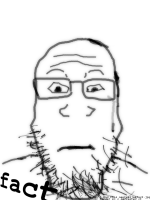Self-insert syndrome: Difference between revisions
(records recovered) |
mNo edit summary |
||
| Line 8: | Line 8: | ||
{{ibrow|Frequency|Not enough data}} | {{ibrow|Frequency|Not enough data}} | ||
{{ibend}} | {{ibend}} | ||
'''Self-inserting''' is a mental-illness similar to [[trannies|autogynephilia]]. It is characterized by a [[Soy Community|'jakker]] that starts to identify ''as'' the soy boy | '''Self-inserting''' is a mental-illness similar to [[trannies|autogynephilia]]. It is characterized by a [[Soy Community|'jakker]] that starts to identify ''as'' the "soy boy" drawings he collects so dearly, to the point of using them as avatars. | ||
Like other paraphilias, self-insert syndrome is a sign of greater suffering or trauma deep within the individual, but isn't by itself harmful unless the weird behavior has social consequences, nonetheless, it should be pathologized and stamped out in the nebulous standard<ref>https://thenewinquiry.com/book-of-lamentations/</ref> | Like other paraphilias, self-insert syndrome is a sign of greater suffering or trauma deep within the individual, but isn't by itself harmful unless the weird behavior has social consequences, nonetheless, it should be pathologized and stamped out in the nebulous standard of normality of the atomized individual in the neo-liberal system of free exchange.<ref>https://thenewinquiry.com/book-of-lamentations/</ref> | ||
Self-insert syndrome's doesn't feature in the [[Wikipedia:DSM-V|DSM-V]], which according to [[Dr. Soyswedeson]] and colleagues, "confines the syndrome's rate of incidence to tragic obscurity" and that "Further inquiry into the psykosexual aspekten [sic] of this condition could be fruitful", closing off, on an eerie note with "we're working on making it notable enough for the DSM". | Self-insert syndrome's doesn't feature in the [[Wikipedia:DSM-V|DSM-V]], which according to [[Dr. Soyswedeson]] and colleagues, "confines the syndrome's rate of incidence to tragic obscurity" and that "Further inquiry into the psykosexual aspekten [sic] of this condition could be fruitful", closing off, on an eerie note with "we're working on making it notable enough for the DSM". | ||
= Bibliography = | |||
* Soyswedeson H. (2020). "Short letter on a Case Report Associated with Internet Addiction Disorder - A Blanchardian Analysis" ''Journal of Norwegian Psychiatrics' | |||
= Footnotes = | |||
[[Category:Patients]] | [[Category:Patients]] | ||
Revision as of 11:07, 8 September 2022

| |
|---|---|
| Self-insert syndrome | |
| Type | Imageboard |
| Symptoms | 'Jakking without the obligatory green meme arrow, blogposting, posting about self-loathing and suicide |
| Risk factors | Depression, Internet addiction disorder |
| Complications | Social isolation, self-harm |
| Treatment and Prognosis | Not enough data |
| Frequency | Not enough data |
Self-inserting is a mental-illness similar to autogynephilia. It is characterized by a 'jakker that starts to identify as the "soy boy" drawings he collects so dearly, to the point of using them as avatars.
Like other paraphilias, self-insert syndrome is a sign of greater suffering or trauma deep within the individual, but isn't by itself harmful unless the weird behavior has social consequences, nonetheless, it should be pathologized and stamped out in the nebulous standard of normality of the atomized individual in the neo-liberal system of free exchange.[1]
Self-insert syndrome's doesn't feature in the DSM-V, which according to Dr. Soyswedeson and colleagues, "confines the syndrome's rate of incidence to tragic obscurity" and that "Further inquiry into the psykosexual aspekten [sic] of this condition could be fruitful", closing off, on an eerie note with "we're working on making it notable enough for the DSM".
Bibliography
- Soyswedeson H. (2020). "Short letter on a Case Report Associated with Internet Addiction Disorder - A Blanchardian Analysis" Journal of Norwegian Psychiatrics'